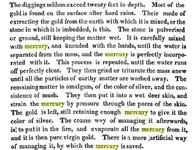
.....you really need to do more research. I didn't say that there wasn't any processes. First you have to locate the region, then research those individual regions. From one state, or region, to the next was often like night and day. But even applying the process you just posted I don't think you're aware of the amount of material involved even in an extremely high essay if that process was employed. In the region in question the silver presented the problem.

What you are describing in the above post is "a basic process" that in many regions produced, "a very low efficiency."




 .....you really need to do more research. I didn't say that there wasn't any processes. First you have to locate the region, then research those individual regions. From one state, or region, to the next was often like night and day. But even applying the process you just posted I don't think you're aware of the amount of material involved even in an extremely high essay if that process was employed. In the region in question the silver presented the problem.
.....you really need to do more research. I didn't say that there wasn't any processes. First you have to locate the region, then research those individual regions. From one state, or region, to the next was often like night and day. But even applying the process you just posted I don't think you're aware of the amount of material involved even in an extremely high essay if that process was employed. In the region in question the silver presented the problem. 
